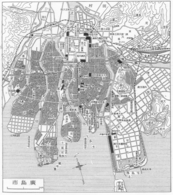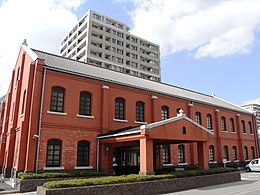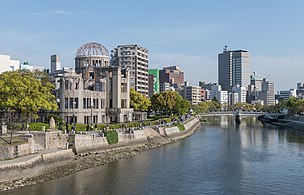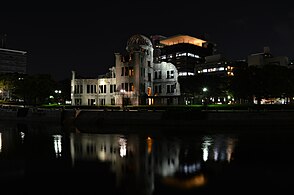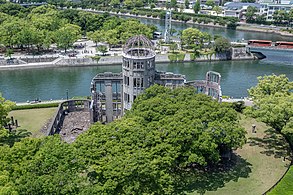
A | B | C | D | E | F | G | H | CH | I | J | K | L | M | N | O | P | Q | R | S | T | U | V | W | X | Y | Z | 0 | 1 | 2 | 3 | 4 | 5 | 6 | 7 | 8 | 9
Hiroshima
広島市 | |
|---|---|
Counter clockwise from top left: Hiroshima skyline within A-Bomb Dome, Hiroshima Castle, Hiroshima Peace Memorial Museum and Park, Tramways in Kamiyacho–Hatchobori area, and the Shukkei-en Garden of Peace | |
 | |
 Location of Hiroshima in Hiroshima Prefecture | |
| Coordinates: 34°23′29″N 132°27′07″E / 34.39139°N 132.45194°E | |
| Country | |
| Region | Chūgoku (San'yō) |
| Prefecture | Hiroshima Prefecture |
| Founded by | Mōri Terumoto |
| Government | |
| • Mayor | Kazumi Matsui |
| Area | |
| • Designated city | 906.68 km2 (350.07 sq mi) |
| Population (June 1, 2019) | |
| • Designated city | 1,199,391 |
| • Density | 1,300/km2 (3,400/sq mi) |
| • Metro [1] (2015) | 1,431,634 (10th) |
| Time zone | UTC+9 (Japan Standard Time) |
| Tree | Camphor Laurel |
| Flower | Oleander |
| Phone number | 082-245-2111 |
| Address | 1-6-34 Kokutaiji, Naka-ku, Hiroshima-shi 730-8586 |
| Website | www |
| Hiroshima | |||||
|---|---|---|---|---|---|
| Japanese name | |||||
| Kyūjitai | 廣島 | ||||
| Shinjitai | 広島 | ||||
| |||||

Hiroshima (広島市, Hiroshima-shi, /ˌhɪroʊˈʃiːmə/, also UK: /hɪˈrɒʃɪmə/,[2] US: /hɪˈroʊʃɪmə/, [çiɾoɕima] ) is the capital of Hiroshima Prefecture in Japan. As of June 1, 2019[update], the city had an estimated population of 1,199,391. The gross domestic product (GDP) in Greater Hiroshima, Hiroshima Urban Employment Area, was US$61.3 billion as of 2010.[3][4] Kazumi Matsui has been the city's mayor since April 2011. The Hiroshima metropolitan area is the second largest urban area in the Chugoku Region of Japan, following the Okayama metropolitan area.
Hiroshima was founded in 1589 as a castle town on the Ōta River delta. Following the Meiji Restoration in 1868, Hiroshima rapidly transformed into a major urban center and industrial hub. In 1889, Hiroshima officially gained city status. The city was a center of military activities during the imperial era, playing significant roles such as in the First Sino-Japanese War, the Russo-Japanese War, and the two world wars.
Hiroshima was the first military target of a nuclear weapon in history. This occurred on August 6, 1945, in the Pacific theatre of World War II, at 8:15 a.m., when the United States Army Air Forces (USAAF) dropped the atomic bomb "Little Boy" on the city.[5] Most of Hiroshima was destroyed, and by the end of the year between 90,000 and 166,000 had died as a result of the blast and its effects. The Hiroshima Peace Memorial (a UNESCO World Heritage Site) serves as a memorial of the bombing.
Since being rebuilt after the war, Hiroshima has become the largest city in the Chūgoku region of western Honshu.
History
Early history
The region where Hiroshima stands today was originally a small fishing village along the shores of Hiroshima Bay. From the 12th century, the village was rather prosperous and was economically attached to a Zen Buddhist temple called Mitaki-Ji. This new prosperity was partly caused by the increase of trade with the rest of Japan under the auspices of the Taira clan.[6]
Sengoku and Edo periods (1589–1871)
Hiroshima was established on the delta coastline of the Seto Inland Sea in 1589 by powerful warlord Mōri Terumoto.[7][8] Hiroshima Castle was quickly built, and in 1593 Mōri moved in. The name Hiroshima means wide island in Japanese. Terumoto was on the losing side at the Battle of Sekigahara. The winner of the battle, Tokugawa Ieyasu, deprived Mōri Terumoto of most of his fiefs, including Hiroshima and gave Aki Province to Masanori Fukushima, a daimyō (Feudal Lord) who had supported Tokugawa.[9] From 1619 until 1871, Hiroshima was ruled by the Asano clan.
- Gallery
-
Fudoin
Meiji and Showa periods (1871–1939)
After the Han was abolished in 1871, the city became the capital of Hiroshima Prefecture. Hiroshima became a major urban center during the imperial period, as the Japanese economy shifted from primarily rural to urban industries. During the 1870s, one of the seven government-sponsored English language schools was established in Hiroshima.[10] Ujina Harbor was constructed through the efforts of Hiroshima Governor Sadaaki Senda in the 1880s, allowing Hiroshima to become an important port city.
The San'yō Railway was extended to Hiroshima in 1894, and a rail line from the main station to the harbor was constructed for military transportation during the First Sino-Japanese War.[11] During that war, the Japanese government moved temporarily to Hiroshima, and Emperor Meiji maintained his headquarters at Hiroshima Castle from September 15, 1894, to April 27, 1895.[11] The significance of Hiroshima for the Japanese government can be discerned from the fact that the first round of talks between Chinese and Japanese representatives to end the Sino-Japanese War was held in Hiroshima, from February 1 to 4, 1895.[12] New industrial plants, including cotton mills, were established in Hiroshima in the late 19th century.[13] Further industrialization in Hiroshima was stimulated during the Russo-Japanese War in 1904, which required development and production of military supplies. The Hiroshima Prefectural Commercial Exhibition Hall was constructed in 1915 as a center for trade and the exhibition of new products. Later, its name was changed to Hiroshima Prefectural Product Exhibition Hall, and again to Hiroshima Prefectural Industrial Promotion Hall.[14] The building, now known as the A-Bomb Dome, part of the Hiroshima Peace Memorial, a World Heritage Site since 1996, permanently remains the only structure still standing and is a state of preserved ruin.
During World War I, Hiroshima became a focal point of military activity, as the Japanese government entered the war on the Allied side. About 500 German P.O.W.'s were held in Ninoshima Island in Hiroshima Bay.[15] The growth of Hiroshima as a city continued after the First World War, as the city now attracted the attention of the Catholic Church, and on May 4, 1923, an Apostolic Vicar was appointed for that city.[16]
- Gallery
-
Old Mitsui Bank Hiroshima Branch (1928)
-
Map of Hiroshima City in the 1930s (Japanese edition)
-
Old Hiroshima Army Weapon Depot
World War II and the atomic bombing (1939–1945)
During World War II, the Second General Army and Chūgoku Regional Army was headquartered in Hiroshima, and the Army Marine Headquarters was located at Ujina port. The city also had large depots of military supplies, and was a key center for shipping.[17]
The bombing of Tokyo and other cities in Japan during World War II caused widespread destruction and hundreds of thousands of civilian deaths.[18] There were no such air raids on Hiroshima. However, a real threat existed and was recognized. To protect against potential firebombings in Hiroshima, school children aged 11–14 years were mobilized to demolish houses and create firebreaks.[19]
On Monday, August 6, 1945, at 8:15 a.m. (Hiroshima time), the American Boeing B-29 Superfortress, the Enola Gay, flown by Paul Tibbets (23 February 1915 – 1 November 2007), dropped the nuclear weapon "Little Boy" on Hiroshima,[20] directly killing at least 70,000 people, including thousands of Korean slave laborers. Fewer than 10% of the casualties were military.[21] By the end of the year, injury and radiation brought the total number of deaths to 90,000–140,000.[22] The population before the bombing was around 345,000. About 70% of the city's buildings were destroyed, and another 7% severely damaged.
The public release of film footage of the city following the attack, and some of the Atomic Bomb Casualty Commission research on the human effects of the attack, were restricted during the occupation of Japan, and much of this information was censored until the signing of the Treaty of San Francisco in 1951, restoring control to the Japanese.[23]
As Ian Buruma observed:
News of the amazing explosion of the atom bomb attacks on Japan was deliberately withheld from the Japanese public by US military censors during the Allied occupation—even as they sought to teach the natives the virtues of a free press. Casualty statistics were suppressed. Film shot by Japanese cameramen in Hiroshima and Nagasaki after the bombings was confiscated. "Hiroshima", the account written by John Hersey for The New Yorker, had a huge impact in the US, but was banned in Japan. As Dower says: "In the localities themselves, suffering was compounded not merely by the unprecedented nature of the catastrophe ... but also by the fact that public struggle with this traumatic experience was not permitted."[24]
The US occupation authorities maintained a monopoly on scientific and medical information about the effects of the atomic bomb through the work of the Atomic Bomb Casualty Commission, which treated the data gathered in studies of hibakusha as privileged information rather than making the results available for the treatment of victims or providing financial or medical support to aid victims.[citation needed]
The book Hiroshima by John Hersey was originally published in article form in the magazine The New Yorker,[25] on August 31, 1946. It is reported to have reached Tokyo, in English, at least by January 1947 and the translated version was released in Japan in 1949.[26] Although the article was planned to be published over four issues, "Hiroshima" made up the entire contents of one issue of the magazine.[27][28] Hiroshima narrates the stories of six bomb survivors immediately before and four months after the dropping of the Little Boy bomb.[25][29]
Oleander (Nerium) is the official flower of the city of Hiroshima because it was the first to bloom again after the explosion of the atomic bomb in 1945.[30]
- Gallery
-
Hiroshima August 1945
-
Hiroshima in October 1945, two months after the bombing
-
Old Teikoku Bank Hiroshima Branch (1945)
Postwar period (1945–present)

On September 17, 1945, Hiroshima was struck by the Makurazaki Typhoon (Typhoon Ida). Hiroshima Prefecture suffered more than 3,000 deaths and injuries, about half the national total.[31] More than half the bridges in the city were destroyed, along with heavy damage to roads and railroads, further devastating the city.[32]
Hiroshima was rebuilt after the war, with help from the national government through the Hiroshima Peace Memorial City Construction Law passed in 1949. It provided financial assistance for reconstruction, along with land donated that was previously owned by the national government and used by the Imperial military.[33]
In 1949, a design was selected for the Hiroshima Peace Memorial Park. Hiroshima Prefectural Industrial Promotion Hall, the closest surviving building to the location of the bomb's detonation, was designated the Genbaku Dome (原爆ドーム) or "Atomic Dome", a part of the Hiroshima Peace Memorial Park. The Hiroshima Peace Memorial Museum was opened in 1955 in the Peace Park.[34] The historic castle of Hiroshima was rebuilt in 1958.
Hiroshima also contains a Peace Pagoda, built in 1966 by Nipponzan-Myōhōji. Uniquely, the pagoda is made of steel, rather than the usual stone.[35]
Hiroshima was proclaimed a City of Peace by the Japanese parliament in 1949, at the initiative of its mayor, Shinzo Hamai (1905–1968).[citation needed] As a result, the city of Hiroshima received more international attention as a desirable location for holding international conferences on peace as well as social issues.[citation needed] As part of that effort, the Hiroshima Interpreters' and Guide's Association (HIGA) was established in 1992 to facilitate interpretation for conferences, and the Hiroshima Peace Institute was established in 1998 within the Hiroshima University. The city government continues to advocate the abolition of all nuclear weapons and the Mayor of Hiroshima is the president of Mayors for Peace, an international Mayoral organization mobilizing cities and citizens worldwide to abolish and eliminate nuclear weapons by 2020.[36][37]
On May 27, 2016, Barack Obama became the first sitting United States president to visit Hiroshima since the atomic bombing.[38] The 49th annual G7 summit was held in Hiroshima in May 2023.[39]
Hiroshima is situated on the Ōta River delta, on Hiroshima Bay, facing the Seto Inland Sea on its south side. The river's six channels divide Hiroshima into several islets.
- Gallery
-
Atomic Bomb Dome by Jan Letzel and modern Hiroshima
-
Atomic Bomb Dome by night
-
Genbaku Dome seen from Orizuru tower in 2019
Geography
Climate
Hiroshima has a humid subtropical climate characterized by cool to mild winters and hot, humid summers. Like much of Japan, Hiroshima experiences a seasonal temperature lag in summer, with August rather than July being the warmest month of the year. Precipitation occurs year-round, although winter is the driest season. Rainfall peaks in June and July, with August experiencing sunnier and drier conditions.
| Climate data for Hiroshima (1991–2020 normals, extremes 1879–present) | |||||||||||||
|---|---|---|---|---|---|---|---|---|---|---|---|---|---|
| Month | Jan | Feb | Mar | Apr | May | Jun | Jul | Aug | Sep | Oct | Nov | Dec | Year |
| Record high °C (°F) | 18.8 (65.8) |
21.5 (70.7) |
23.7 (74.7) |
29.0 (84.2) |
31.5 (88.7) |
34.4 (93.9) |
38.7 (101.7) |
38.1 (100.6) |
37.4 (99.3) |
31.4 (88.5) |
26.3 (79.3) |
22.3 (72.1) |
38.7 (101.7) |
| Mean daily maximum °C (°F) | 9.9 (49.8) |
10.9 (51.6) |
14.5 (58.1) |
19.8 (67.6) |
24.4 (75.9) |
27.2 (81.0) |
30.9 (87.6) |
32.8 (91.0) |
29.1 (84.4) |
23.7 (74.7) |
17.7 (63.9) |
12.1 (53.8) |
21.1 (70.0) |
| Daily mean °C (°F) | 5.4 (41.7) |
6.2 (43.2) |
9.5 (49.1) |
14.8 (58.6) |
Zdroj:https://en.wikipedia.org?pojem=Hiroshima_City|||||||||
















